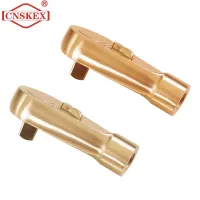What should be paid attention to when using explosion-proof tools in explosion-hazardous areas?
Sep. 18, 2024
Explosion-proof tools are spark-free tools, which refer to tools used in flammable and explosive hazardous places. They are characterized by explosion-proof performance and can effectively avoid fire or explosion caused by static electricity, sparks and other factors. The scope of use of explosion-proof tools is very wide, including petrochemical, coal mining, fertilizer, printing and dyeing, pharmaceutical, food and other industries. In these places, the use of explosion-proof tools is indispensable. In short, the use of explosion-proof tools must comply with the provisions of national standards and industry standards to ensure safe and reliable use.
1. The requirements for the use of explosion-proof tools in the production and use of flammable and explosive hazardous chemicals can be referred to:
1. Article 8 of the Ten Regulations on Fire and Explosion Prevention in Oil and Gas Tank Areas issued by the State Administration of Work Safety Order No. 84: It is strictly forbidden to use non-explosion-proof lighting, electrical facilities, tools and electronic equipment in oil and gas tank areas.
2. GB4962-2008 "Technical Regulations for Safety in the Use of Hydrogen" 4.2.3: Tools that do not produce sparks should be used during operations.
3. Article 28 of the Safety Regulations for Explosion Hazardous Places (1995) No. 56 issued by the former Ministry of Labor stipulates that effective explosion-proof measures should be taken for motor vehicles used in explosion-hazardous places. Tools and protective equipment used by operators should meet explosion-proof requirements.
4. GB24459-2009 "Beryllium Copper Alloy Explosion-Proof Tools".
5. GB/T 10686-2013 "Test Method for Explosion-Proof Performance of Copper Alloy Tools".
6. GB/T 3836.1-2021 "General Requirements for Equipment in Explosive Atmospheres Part 1" 8.5 stipulates that if the equipment housing and the Ex component housing for external installation are made of copper or copper alloy and are intended to be used in an environment containing acetylene, they shall meet the following requirements:
(1) Coated with zinc, nickel or other coatings; or the maximum copper content in the alloy shall not exceed 65%.
(2) Cable entry devices, plugging parts, threaded pipe joints and insulating sleeves specified in Appendix A are not considered as housing surfaces requiring coatings or copper content restrictions.
Note: The restriction on use in acetylene environment is due to the possibility of forming acetylide on the outer surface that can be ignited by friction or impact.
7. Article 36 of the "Safety Production Law" The design, manufacture, installation, use, inspection, maintenance, modification and scrapping of safety equipment shall comply with national standards or industry standards.
2. Matters for the use and management of Non-sparking tools

Explosion-proof tools are a special safety tool that has the characteristic of not generating sparks when the tool collides or rubs with the workpiece.
Further reading:Why Are Electric Leaf Blowers Gaining Popularity?
what are angle grinders used for
Electric Drilling: The Ultimate Guide to Choosing the Best Tools
Most varieties and specifications are evolved from steel tools, but the material is made of multi-element non-ferrous metals with copper as the base, and some products are specially designed. Therefore, there are certain requirements for its use, maintenance, storage and transportation.
1. Explosion-proof tools are a kind of safety protection products, so users must purchase products that have been tested and identified as qualified by nationally recognized explosion-proof performance testing units.
When purchasing, you must carefully understand the scope of application, performance, characteristics, use methods and precautions specified in its instructions. In addition, the tool body is usually marked with the "Ex" mark and has a certificate of conformity. Tools without marks cannot be purchased and used casually.
2. Before using spark-free tools, the combustible gas in the workplace should be compared with the explosion-proof test gas; products that have passed the test with a higher level of medium can be used in places with a lower level of danger.
Conversely, products that have passed the test with a lower level of medium cannot be used in places with a higher level of danger. If there is a special need, please ask the manufacturer to go to the testing unit and use it after passing the test.
Obviously, it should not be used as an ordinary tool in non-hazardous places to avoid losing its proper performance.
It should be pointed out that it should not be used as a substitute at will. If the current production specifications cannot meet the user's needs, special design and manufacturing should be applied.
3. Explosion-proof media are high-strength and corrosion-resistant in most medium gases. But it is not corrosion-resistant in all cases, such as in wet ammonia, certain ammonium salts, acetylene, wet fluorine, chlorine, chromium ammonium, certain dichromates, potassium hydride and other media. The degree of corrosion is quite large.
Some media will also react chemically after contact with copper alloys to generate highly dangerous explosive substances, such as acetylene steel generated by the combination of acetylene and steel.
Therefore, when using explosion-proof tools, try to use them in a dry environment. If it is impossible to avoid using them in a humid environment, try to speed up the operation and reduce the working time to avoid causing greater corrosion and danger. Wipe clean at any time after use, and it is strictly forbidden to store them together with corrosive media.
4. All types of wrenches of explosion-proof hand tools have different rated strengths. It is strictly forbidden to use them with overload sleeves. Except for knocking wrenches, they must not be knocked, so as not to cause overload fracture and deformation, affecting normal use.
In the process of using tools, the variety and specifications should be reasonably selected according to needs. Small ones should not be used instead of large ones, and they should not be treated as steel tools. It should also be pointed out that when using adjustable wrenches, pipe clamps, and fixed wrenches, attention should be paid to the requirements of the force direction, and no reverse force should be applied arbitrarily. When using tools with blades, the hardness of the workpiece itself should be measured first. If its hardness is close to the hardness of the tool, it should be operated carefully. If it is higher than the hardness of the tool, it is prohibited to use it.
When the workpiece is tightened by a motor, semi-permanently fixed or rusted for a long time, and no other measures are taken before using the manual tool, it should be prohibited to use it to avoid damaging the tool.
5. After the explosion-proof safety tool is out of use, it should be wiped clean at any time. If it is not used within half a year, it should be oiled or preserved by anti-corrosion method. If it is out of use for more than one year, it should be oiled and stored in a bag or box.
For the used tools, some parts are naturally worn or damaged, especially the tools with blades. They can be repaired in non-hazardous places. If the damage and wear are serious and it is not suitable for self-repair, it should be scrapped and cannot be operated with defects.
167
0
0
All Comments (0)
Previous: How to Choose a Brushless Electric Screwdriver?
Next: None
If you are interested in sending in a Guest Blogger Submission,welcome to write for us!


Comments